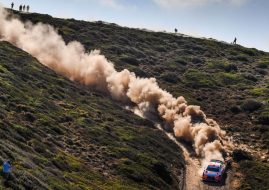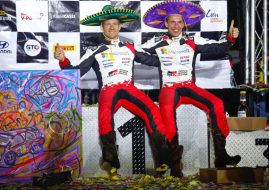FIA announced stronger and better looking World Rally Cars from 2017
The FIA World Motor Sport Council at a meeting in Mexico City yesterday approved a set of the new technical and homologation regulations for World Rally Cars from 2017. The new regulations are an evolution of the current 2014-2016 regulations but will deliver things that fans love the most: more power and more freedom in design.
The 2017 regulations see enhancements to the engine and the visual impact created by an all-new aerodynamic package will dramatically enrich the spectacle of these cars and provide far greater diversity.
The 1.6 litre turbo engine has been retained but the power will be increased up to the level of the WTCC race cars of about 380 hp. The diameter of the turbo restrictor will be increased from 33mm to 36mm while the turbo pressure remains at a maximum 2.5b absolute. The minimum weight of the car has also been reduced by 25 kilograms.

Greater freedom has also been given with respect to aerodynamics, setting this World Rally Car aside from many of its recent predecessors. A free zone defined around the bodyshell of the production car could see a front bumper overhang by an additional 60 mm, potentially also with additional aero devices ahead of the front wheels, while the rear overhang can be increased by an extra 30 mm.
Bigger door sills will also be part of the newly permitted rules. The fixed rear wing can be dramatically increased in size while the rear diffuser will have maximum permitted dimensions, the shape will be free and may protrude up to 50 mm from the rear bumper.
The WRC car will be issued from a production car from which the overall homologated length must be greater than or equal to 3.9 metres, potentially adding further opportunities for manufacturers.

“I think that the ideas for the look and performance of the 2017 car are great news. As a racing driver you are always looking for more performance. I think the larger wing and new aerodynamics will give the car a bit more downforce, more grip and more speed going into the corners. This is also good for the show, because the extra power will definitely make the driving more spectacular for the fans. And it will also make the car look a bit more aggressive with a wider body – I am really looking forward to seeing the next generation of the Polo R WRC,” said Volkswagen Motorsport’s double FIA World Rally Champion Sébastien Ogier.
The other manufacturers’ representatives currently competing in the FIA World Rally Championship were equally enthusiastic and similarly unanimous about the prospect of exciting new regulations for 2017.
Michel Nandan, Team Principal at Hyundai Motorsport said: “WRC has benefited from stable regulations over the past few years, which have been good for companies like Hyundai coming into the sport. The current rules have afforded us flexibility and ease in adapting the standard road car to develop it into a WRC specification. The changes for 2017 are, however, even more ‘manufacturer appropriate’ in that we have even more freedom to work on the car, for example on the suspension, and to push the design envelope of the car, which will consequently be more powerful, larger and look more aggressive. All in all, it will be another positive step forward to improve the value of the WRC and to take the sport into an exciting new era.”

M-Sport Managing Director, Malcolm Wilson OBE agreed: “These new regulations mark the start of an exciting new era for the FIA World Rally Championship. Not only will the 2017 cars look a lot more spectacular, but we will also see an increase in power and performance. The concept really does remind me of the Group B days. When you combine the exhilaration of that era with the fantastic safety measures that the FIA have worked to implement, this marks the start of a thrilling new chapter for the WRC. Although the cars will look completely different and there will be some substantial work on the bodyshell, a number of key components can be enhanced and carried over from our current car. From a financial point of view, a number of parts that we are currently working to develop can be taken a step further and the whole team is really looking forward to getting started on this new project.”
Toyota will also return to the WRC in 2017 with a team known as Toyota Gazoo Racing, reflecting the shared identity of the Japanese manufacturer’s other international motorsport activities. They invited the legendary Tommi Mäkinen to lead their WRC project and under his leadership, the team will proceed with developing Yaris WRC based on 2017 regulations.






